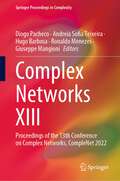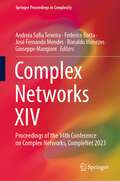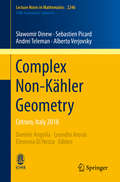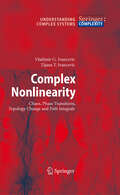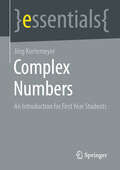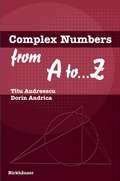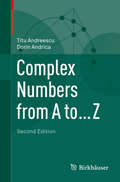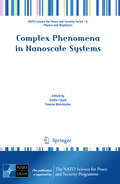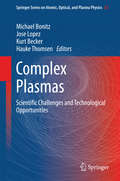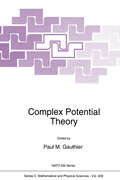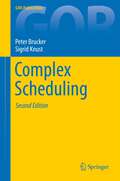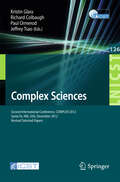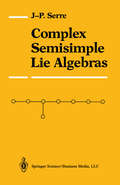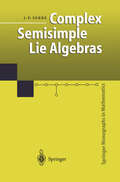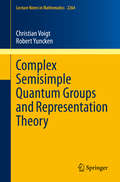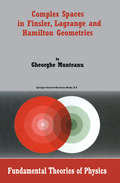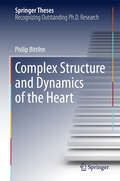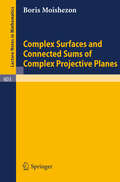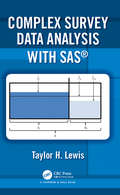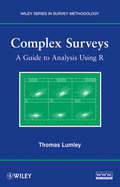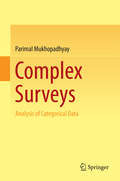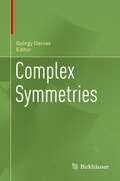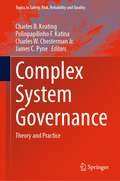- Table View
- List View
Complex Networks XIII: Proceedings of the 13th Conference on Complex Networks, CompleNet 2022 (Springer Proceedings in Complexity)
by Diogo Pacheco Andreia Sofia Teixeira Hugo Barbosa Ronaldo Menezes Giuseppe MangioniThis book contains contributions presented at the 13th International Conference on Complex Networks (CompleNet), April 19–22, 2022. CompleNet is an international conference on complex networks that brings together researchers and practitioners from diverse disciplines—from sociology, biology, physics, and computer science—who share a passion to better understand the interdependencies within and across systems. CompleNet is a venue to discuss ideas and findings about all types of networks, from biological to technological and to informational and social. It is this interdisciplinary nature of complex networks that CompleNet aims to explore and celebrate.
Complex Networks XIV: Proceedings of the 14th Conference on Complex Networks, CompleNet 2023 (Springer Proceedings in Complexity)
by Andreia Sofia Teixeira Federico Botta José Fernando Mendes Ronaldo Menezes Giuseppe MangioniThis book contains contributions in the area of Network Science, presented at the 14th International Conference on Complex Networks (CompleNet), 24-28 April, 2023 in Aveiro, Portugal. CompleNet is an international conference on complex networks that brings together researchers and practitioners from diverse disciplines—from sociology, biology, physics, and computer science—who share a passion to better understand the interdependencies within and across systems. CompleNet is a venue to discuss ideas and findings about all types networks, from biological, to technological, to informational and social. It is this interdisciplinary nature of complex networks that CompleNet aims to explore and celebrate.The audience of the work are professionals and academics working in Network Science, a highly-multidisciplinary field.
Complex Non-Kähler Geometry: Cetraro, Italy 2018 (Lecture Notes in Mathematics #2246)
by Sławomir Dinew Sebastien Picard Andrei Teleman Alberto VerjovskyCollecting together the lecture notes of the CIME Summer School held in Cetraro in July 2018, the aim of the book is to introduce a vast range of techniques which are useful in the investigation of complex manifolds. The school consisted of four courses, focusing on both the construction of non-Kähler manifolds and the understanding of a possible classification of complex non-Kähler manifolds. In particular, the courses by Alberto Verjovsky and Andrei Teleman introduced tools in the theory of foliations and analytic techniques for the classification of compact complex surfaces and compact Kähler manifolds, respectively. The courses by Sebastien Picard and Sławomir Dinew focused on analytic techniques in Hermitian geometry, more precisely, on special Hermitian metrics and geometric flows, and on pluripotential theory in complex non-Kähler geometry.
Complex Nonlinearity: Chaos, Phase Transitions, Topology Change and Path Integrals (Understanding Complex Systems)
by Vladimir G. Ivancevic Tijana T. IvancevicComplex Nonlinearity: Chaos, Phase Transitions, Topology Change and Path Integrals is a book about prediction & control of general nonlinear and chaotic dynamics of high-dimensional complex systems of various physical and non-physical nature and their underpinning geometro-topological change. The book starts with a textbook-like expose on nonlinear dynamics, attractors and chaos, both temporal and spatio-temporal, including modern techniques of chaos–control. Chapter 2 turns to the edge of chaos, in the form of phase transitions (equilibrium and non-equilibrium, oscillatory, fractal and noise-induced), as well as the related field of synergetics. While the natural stage for linear dynamics comprises of flat, Euclidean geometry (with the corresponding calculation tools from linear algebra and analysis), the natural stage for nonlinear dynamics is curved, Riemannian geometry (with the corresponding tools from nonlinear, tensor algebra and analysis). The extreme nonlinearity – chaos – corresponds to the topology change of this curved geometrical stage, usually called configuration manifold. Chapter 3 elaborates on geometry and topology change in relation with complex nonlinearity and chaos. Chapter 4 develops general nonlinear dynamics, continuous and discrete, deterministic and stochastic, in the unique form of path integrals and their action-amplitude formalism. This most natural framework for representing both phase transitions and topology change starts with Feynman’s sum over histories, to be quickly generalized into the sum over geometries and topologies. The last Chapter puts all the previously developed techniques together and presents the unified form of complex nonlinearity. Here we have chaos, phase transitions, geometrical dynamics and topology change, all working together in the form of path integrals. The objective of this book is to provide a serious reader with a serious scientific tool that will enable them to actually perform a competitive research in modern complex nonlinearity. It includes a comprehensive bibliography on the subject and a detailed index. Target readership includes all researchers and students of complex nonlinear systems (in physics, mathematics, engineering, chemistry, biology, psychology, sociology, economics, medicine, etc.), working both in industry/clinics and academia.
Complex Numbers: An Introduction for First Year Students (essentials)
by Jörg KortemeyerComplex numbers are a typical topic of basic mathematics courses. This essential provides a detailed introduction and presentation of essential aspects of dealing with complex numbers, on the one hand related to commonly occurring tasks and on the other hand embedded in basic mathematical content. This Springer essential is a translation of the original German 1st edition essentials Komplexe Zahlen by Jörg Kortemeyer, published by Springer Fachmedien Wiesbaden GmbH, part of Springer Nature in 2020. The translation was done with the help of artificial intelligence (machine translation by the service DeepL.com). A subsequent human revision was done primarily in terms of content, so that the book will read stylistically differently from a conventional translation. Springer Nature works continuously to further the development of tools for the production of books and on the related technologies to support the authors.
Complex Numbers from A to ...Z
by Titu Andreescu Dorin Andrica* Learn how complex numbers may be used to solve algebraic equations, as well as their geometric interpretation * Theoretical aspects are augmented with rich exercises and problems at various levels of difficulty * A special feature is a selection of outstanding Olympiad problems solved by employing the methods presented * May serve as an engaging supplemental text for an introductory undergrad course on complex numbers or number theory
Complex Numbers from A to ... Z
by Titu Andreescu Dorin Andrica* Learn how complex numbers may be used to solve algebraic equations, as well as their geometric interpretation* Theoretical aspects are augmented with rich exercises and problems at various levels of difficulty* A special feature is a selection of outstanding Olympiad problems solved by employing the methods presented* May serve as an engaging supplemental text for an introductory undergrad course on complex numbers or number theory
Complex Phenomena in Nanoscale Systems (NATO Science for Peace and Security Series B: Physics and Biophysics)
by Giulio Casati Davron MatrasulovNanoscale physics has become one of the rapidly developing areas of contemporary physics because of its direct relevance to newly emerging area, nanotechnologies. Nanoscale devices and quantum functional materials are usually constructed based on the results of fundamental studies on nanoscale physics. Therefore studying physical phenomena in nanosized systems is of importance for progressive development of nanotechnologies. In this context study of complex phenomena in such systems and using them for controlling purposes is of great practical importance. Namely, such studies are brought together in this book, which contains 27 papers on various aspects of nanoscale physics and nonlinear dynamics.
Complex Plasmas: Scientific Challenges and Technological Opportunities (Springer Series on Atomic, Optical, and Plasma Physics #82)
by Michael Bonitz Jose Lopez Kurt Becker Hauke ThomsenThis book provides the reader with an introduction to the physics of complex plasmas, a discussion of the specific scientific and technical challenges they present and an overview of their potential technological applications.Complex plasmas differ from conventional high-temperature plasmas in several ways: they may contain additional species, including nano meter- to micrometer-sized particles, negative ions, molecules and radicals and they may exhibit strong correlations or quantum effects. This book introduces the classical and quantum mechanical approaches used to describe and simulate complex plasmas. It also covers some key experimental techniques used in the analysis of these plasmas, including calorimetric probe methods, IR absorption techniques and X-ray absorption spectroscopy.The final part of the book reviews the emerging applications of microcavity and microchannel plasmas, the synthesis and assembly of nanomaterials through plasma electrochemistry, the large-scale generation of ozone using microplasmas and novel applications of atmospheric-pressure non-thermal plasmas in dentistry.Going beyond the scope of traditional plasma texts, the presentation is very well suited for senior undergraduate, graduate students and postdoctoral researchers specializing in plasma physics.
Complex Potential Theory (Nato Science Series C: #439)
by Gert SabidussiProceedings of the NATO Advanced Study Institute and Séminaire de mathématiques supérieures, Montréal, Canada, July 26--August 6, 1993
Complex Scheduling (GOR-Publications)
by Peter Brucker Sigrid KnustThis book presents models and algorithms for complex scheduling problems. Besides resource-constrained project scheduling problems with applications also job-shop problems with flexible machines, transportation or limited buffers are discussed. Discrete optimization methods like linear and integer programming, constraint propagation techniques, shortest path and network flow algorithms, branch-and-bound methods, local search and genetic algorithms, and dynamic programming are presented. They are used in exact or heuristic procedures to solve the introduced complex scheduling problems. Furthermore, methods for calculating lower bounds are described. Most algorithms are formulated in detail and illustrated with examples. In this second edition some errors were corrected, some parts were explained in more detail, and new material has been added. In particular, further generalizations of the RCPSP, additional practical applications and some more algorithms were integrated.
Complex Sciences: Second International Conference, COMPLEX 2012, Santa Fe, NM, USA, December 5-7, 2012, Revised Selected Papers (Lecture Notes of the Institute for Computer Sciences, Social Informatics and Telecommunications Engineering #126)
by Kristin Glass Richard Colbaugh Paul Ormerod Jeffrey TsaoThis book constitutes the thoroughly refereed post-conference proceedings of the Second International ICST Conference on Complex Sciences, COMPLEX 2012, held in Santa Fe, New Mexico, USA in December 2012. The 29 revised full papers presented were carefully reviewed and selected from various submissions. The papers cover aspects on foundations and analysis of complex systems, complex biological systems, complex social systems, complex engineering systems.
Complex Semisimple Lie Algebras
by Jean-Pierre SerreThese notes are a record of a course given in Algiers from lOth to 21st May, 1965. Their contents are as follows. The first two chapters are a summary, without proofs, of the general properties of nilpotent, solvable, and semisimple Lie algebras. These are well-known results, for which the reader can refer to, for example, Chapter I of Bourbaki or my Harvard notes. The theory of complex semisimple algebras occupies Chapters III and IV. The proofs of the main theorems are essentially complete; however, I have also found it useful to mention some complementary results without proof. These are indicated by an asterisk, and the proofs can be found in Bourbaki, Groupes et Algebres de Lie, Paris, Hermann, 1960-1975, Chapters IV-VIII. A final chapter shows, without proof, how to pass from Lie algebras to Lie groups (complex-and also compact). It is just an introduction, aimed at guiding the reader towards the topology of Lie groups and the theory of algebraic groups. I am happy to thank MM. Pierre Gigord and Daniel Lehmann, who wrote up a first draft of these notes, and also Mlle. Franr,:oise Pecha who was responsible for the typing of the manuscript.
Complex Semisimple Lie Algebras (Springer Monographs in Mathematics)
by Jean-Pierre SerreThese short notes, already well-known in their original French edition, present the basic theory of semisimple Lie algebras over the complex numbers. The author begins with a summary of the general properties of nilpotent, solvable, and semisimple Lie algebras. Subsequent chapters introduce Cartan subalgebras, root systems, and linear representations. The last chapter discusses the connection between Lie algebras, complex groups and compact groups. The book is intended to guide the reader towards further study.
Complex Semisimple Quantum Groups and Representation Theory (Lecture Notes in Mathematics #2264)
by Christian Voigt Robert YunckenThis book provides a thorough introduction to the theory of complex semisimple quantum groups, that is, Drinfeld doubles of q-deformations of compact semisimple Lie groups. The presentation is comprehensive, beginning with background information on Hopf algebras, and ending with the classification of admissible representations of the q-deformation of a complex semisimple Lie group. The main components are: - a thorough introduction to quantized universal enveloping algebras over general base fields and generic deformation parameters, including finite dimensional representation theory, the Poincaré-Birkhoff-Witt Theorem, the locally finite part, and the Harish-Chandra homomorphism, - the analytic theory of quantized complex semisimple Lie groups in terms of quantized algebras of functions and their duals, - algebraic representation theory in terms of category O, and - analytic representation theory of quantized complex semisimple groups. Given its scope, the book will be a valuable resource for both graduate students and researchers in the area of quantum groups.
Complex Spaces in Finsler, Lagrange and Hamilton Geometries (Fundamental Theories of Physics #141)
by Gheorghe MunteanuFrom a historical point of view, the theory we submit to the present study has its origins in the famous dissertation of P. Finsler from 1918 ([Fi]). In a the classical notion also conventional classification, Finsler geometry has besides a number of generalizations, which use the same work technique and which can be considered self-geometries: Lagrange and Hamilton spaces. Finsler geometry had a period of incubation long enough, so that few math ematicians (E. Cartan, L. Berwald, S.S. Chem, H. Rund) had the patience to penetrate into a universe of tensors, which made them compare it to a jungle. To aU of us, who study nowadays Finsler geometry, it is obvious that the qualitative leap was made in the 1970's by the crystallization of the nonlinear connection notion (a notion which is almost as old as Finsler space, [SZ4]) and by work-skills into its adapted frame fields. The results obtained by M. Matsumoto (coUected later, in 1986, in a monograph, [Ma3]) aroused interest not only in Japan, but also in other countries such as Romania, Hungary, Canada and the USA, where schools of Finsler geometry are founded and are presently widely recognized.
Complex Structure and Dynamics of the Heart (Springer Theses)
by Philip BittihnThis award-winning thesis investigates the mechanisms underlying cardiac arrhythmia development and termination from an entirely new perspective. By viewing the heart as a complex system, the author uses theoretical tools from nonlinear dynamics combined with numerical simulations and experiments to achieve insights into the relationship between its structure and dynamics, thereby paving the way towards innovative low-energy defibrillation strategies. The work tackles, among other things: the effect of substrate heterogeneity on the spatial-temporal dynamics of cardiac arrhythmias and ways in which weak pulsed electric fields can be used to control these dynamics in heterogeneous cardiac tissue. The long-term vision of this research is to replace the current strategy of applying painful and sometimes tissue damaging electric shock – currently the only reliable way to terminate life-threatening fibrillation – by a more subtle but equally effective intervention. The book maps out a number of promising research directions for biophysicists and medical researchers working on the origins and treatment of cardiac arrhythmias.
Complex Surfaces and Connected Sums of Complex Projective Planes (Lecture Notes in Mathematics #603)
by B. MoishezonComplex Survey Data Analysis with SAS
by Taylor H. LewisComplex Survey Data Analysis with SAS® is an invaluable resource for applied researchers analyzing data generated from a sample design involving any combination of stratification, clustering, unequal weights, or finite population correction factors. After clearly explaining how the presence of these features can invalidate the assumptions underlying most traditional statistical techniques, this book equips readers with the knowledge to confidently account for them during the estimation and inference process by employing the SURVEY family of SAS/STAT® procedures. The book offers comprehensive coverage of the most essential topics, including: Drawing random samples Descriptive statistics for continuous and categorical variables Fitting and interpreting linear and logistic regression models Survival analysis Domain estimation Replication variance estimation methods Weight adjustment and imputation methods for handling missing data The easy-to-follow examples are drawn from real-world survey data sets spanning multiple disciplines, all of which can be downloaded for free along with syntax files from the author’s website: http://mason.gmu.edu/~tlewis18/. While other books may touch on some of the same issues and nuances of complex survey data analysis, none features SAS exclusively and as exhaustively. Another unique aspect of this book is its abundance of handy workarounds for certain techniques not yet supported as of SAS Version 9.4, such as the ratio estimator for a total and the bootstrap for variance estimation. Taylor H. Lewis is a PhD graduate of the Joint Program in Survey Methodology at the University of Maryland, College Park, and an adjunct professor in the George Mason University Department of Statistics. An avid SAS user for 15 years, he is a SAS Certified Advanced programmer and a nationally recognized SAS educator who has produced dozens of papers and workshops illustrating how to efficiently and effectively conduct statistical analyses using SAS.
Complex Survey Data Analysis with SAS
by Taylor H. LewisComplex Survey Data Analysis with SAS® is an invaluable resource for applied researchers analyzing data generated from a sample design involving any combination of stratification, clustering, unequal weights, or finite population correction factors. After clearly explaining how the presence of these features can invalidate the assumptions underlying most traditional statistical techniques, this book equips readers with the knowledge to confidently account for them during the estimation and inference process by employing the SURVEY family of SAS/STAT® procedures. The book offers comprehensive coverage of the most essential topics, including: Drawing random samples Descriptive statistics for continuous and categorical variables Fitting and interpreting linear and logistic regression models Survival analysis Domain estimation Replication variance estimation methods Weight adjustment and imputation methods for handling missing data The easy-to-follow examples are drawn from real-world survey data sets spanning multiple disciplines, all of which can be downloaded for free along with syntax files from the author’s website: http://mason.gmu.edu/~tlewis18/. While other books may touch on some of the same issues and nuances of complex survey data analysis, none features SAS exclusively and as exhaustively. Another unique aspect of this book is its abundance of handy workarounds for certain techniques not yet supported as of SAS Version 9.4, such as the ratio estimator for a total and the bootstrap for variance estimation. Taylor H. Lewis is a PhD graduate of the Joint Program in Survey Methodology at the University of Maryland, College Park, and an adjunct professor in the George Mason University Department of Statistics. An avid SAS user for 15 years, he is a SAS Certified Advanced programmer and a nationally recognized SAS educator who has produced dozens of papers and workshops illustrating how to efficiently and effectively conduct statistical analyses using SAS.
Complex Surveys: A Guide to Analysis Using R (Wiley Series in Survey Methodology #565)
by Thomas LumleyA complete guide to carrying out complex survey analysis using R As survey analysis continues to serve as a core component of sociological research, researchers are increasingly relying upon data gathered from complex surveys to carry out traditional analyses. Complex Surveys is a practical guide to the analysis of this kind of data using R, the freely available and downloadable statistical programming language. As creator of the specific survey package for R, the author provides the ultimate presentation of how to successfully use the software for analyzing data from complex surveys while also utilizing the most current data from health and social sciences studies to demonstrate the application of survey research methods in these fields. The book begins with coverage of basic tools and topics within survey analysis such as simple and stratified sampling, cluster sampling, linear regression, and categorical data regression. Subsequent chapters delve into more technical aspects of complex survey analysis, including post-stratification, two-phase sampling, missing data, and causal inference. Throughout the book, an emphasis is placed on graphics, regression modeling, and two-phase designs. In addition, the author supplies a unique discussion of epidemiological two-phase designs as well as probability-weighting for causal inference. All of the book's examples and figures are generated using R, and a related Web site provides the R code that allows readers to reproduce the presented content. Each chapter concludes with exercises that vary in level of complexity, and detailed appendices outline additional mathematical and computational descriptions to assist readers with comparing results from various software systems. Complex Surveys is an excellent book for courses on sampling and complex surveys at the upper-undergraduate and graduate levels. It is also a practical reference guide for applied statisticians and practitioners in the social and health sciences who use statistics in their everyday work.
Complex Surveys: A Guide to Analysis Using R (Wiley Series in Survey Methodology #565)
by Thomas LumleyA complete guide to carrying out complex survey analysis using R As survey analysis continues to serve as a core component of sociological research, researchers are increasingly relying upon data gathered from complex surveys to carry out traditional analyses. Complex Surveys is a practical guide to the analysis of this kind of data using R, the freely available and downloadable statistical programming language. As creator of the specific survey package for R, the author provides the ultimate presentation of how to successfully use the software for analyzing data from complex surveys while also utilizing the most current data from health and social sciences studies to demonstrate the application of survey research methods in these fields. The book begins with coverage of basic tools and topics within survey analysis such as simple and stratified sampling, cluster sampling, linear regression, and categorical data regression. Subsequent chapters delve into more technical aspects of complex survey analysis, including post-stratification, two-phase sampling, missing data, and causal inference. Throughout the book, an emphasis is placed on graphics, regression modeling, and two-phase designs. In addition, the author supplies a unique discussion of epidemiological two-phase designs as well as probability-weighting for causal inference. All of the book's examples and figures are generated using R, and a related Web site provides the R code that allows readers to reproduce the presented content. Each chapter concludes with exercises that vary in level of complexity, and detailed appendices outline additional mathematical and computational descriptions to assist readers with comparing results from various software systems. Complex Surveys is an excellent book for courses on sampling and complex surveys at the upper-undergraduate and graduate levels. It is also a practical reference guide for applied statisticians and practitioners in the social and health sciences who use statistics in their everyday work.
Complex Surveys: Analysis of Categorical Data
by Parimal MukhopadhyayThe primary objective of this book is to study some of the research topics in the area of analysis of complex surveys which have not been covered in any book yet. It discusses the analysis of categorical data using three models: a full model, a log-linear model and a logistic regression model. It is a valuable resource for survey statisticians and practitioners in the field of sociology, biology, economics, psychology and other areas who have to use these procedures in their day-to-day work. It is also useful for courses on sampling and complex surveys at the upper-undergraduate and graduate levels. The importance of sample surveys today cannot be overstated. From voters’ behaviour to fields such as industry, agriculture, economics, sociology, psychology, investigators generally resort to survey sampling to obtain an assessment of the behaviour of the population they are interested in. Many large-scale sample surveys collect data using complex survey designs like multistage stratified cluster designs. The observations using these complex designs are not independently and identically distributed – an assumption on which the classical procedures of inference are based. This means that if classical tests are used for the analysis of such data, the inferences obtained will be inconsistent and often invalid. For this reason, many modified test procedures have been developed for this purpose over the last few decades.
Complex Symmetries
This volume is a collection of essays on complex symmetries. It is curated, emphasizing the analysis of the symmetries, not the various phenomena that display those symmetries themselves. With this, the volume provides insight to nonspecialist readers into how individual simple symmetries constitute complex symmetry. The authors and the topics cover many different disciplines in various sciences and arts. Simple symmetries, such as reflection, rotation, translation, similitude, and a few other simple manifestations of the phenomenon, are all around, and we are aware of them in our everyday lives. However, there are myriads of complex symmetries (composed of a bulk of simple symmetries) as well. For example, the well-known helix represents the combination of translational and rotational symmetry. Nature produces a great variety of such complex symmetries. So do the arts. The contributions in this volume analyse selected examples (not limited to geometric symmetries). These include physical symmetries, functional (meaning not morphological) symmetries, such as symmetries in the construction of the genetic code, symmetries in human perception (e.g., in geometry education as well as in constructing physical theories), symmetries in fractal structures and structural morphology, including quasicrystal and fullerene structures in stable bindings and their applications in crystallography and architectural design, as well as color symmetries in the arts. The volume is rounded of with beautiful illustrations and presents a fascinating panorama of this interdisciplinary topic.
Complex System Governance: Theory and Practice (Topics in Safety, Risk, Reliability and Quality #40)
by Charles B. Keating Polinpapilinho F. Katina Charles W. Chesterman Jr. James C. PyneThis book explores Complex System Governance (CSG)—an emerging field concerned with the design, execution, and evolution of essential functions necessary to ensure continued viability of a system. The book focuses on three primary development areas to better understand and utilize current developments CSG. First, the conceptual foundations for CSG are developed, from systems theory, management cybernetics, and governance. Second, a set of critical CSG topics are examined from conceptual as well as practice perspectives. Third, several development and application issues are discussed. Ultimately, CSG is positioned as an emerging field with strong theoretical grounding and significant implications for improving practices and performance to better address complex systems and their problems.
